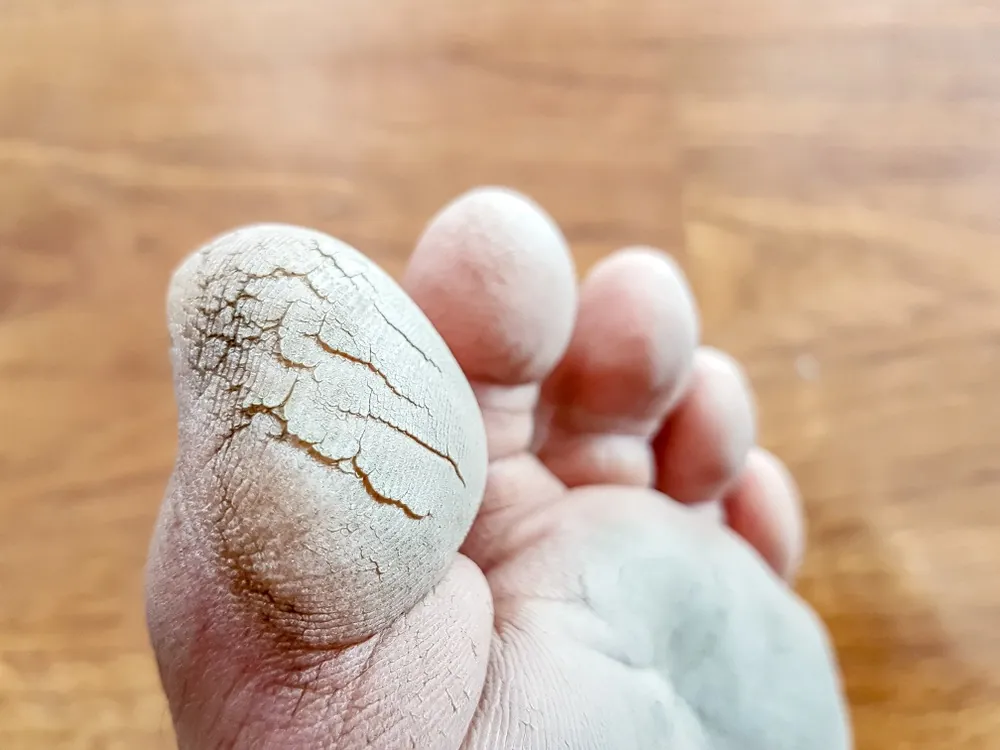Plantar fissures appear mainly on the heel and forefoot.
They occur as a result of pressure on the soles of the feet.
Thus, it is not altogether wrong to associate plantar fissures with other dermatological foot problems like corns and calluses.
Nevertheless, plantar fissures can be distinguished from these dermatoses, particularly by the locations where they appear.
Untreated fissures can sometimes result in uncomfortable complications.
It is therefore advantageous to be able to identify them in order to avoid unnecessary inconveniences.
Here are some of the characteristics of plantar fissures.
Early warning signs
The result of friction or inadequate pressure on the sole of the foot, plantar fissures progress through different stages before becoming a real problem.
The following indications are warning signs that plantar fissures may appear:
- A corn builds up in the heel area and occasionally under the forefoot.
- The affected area has a whitish appearance.
- Dead skin and flaky areas spread.
- Plantar skin is rougher and drier than usual.
- Heel blisters frequently return.
Eventually, if left untreated, these unpleasant symptoms lead to more serious lesions like plantar fissures.
The following signs can be distinguished:
- Loss of elasticity of the skin membrane under the foot
- Formation of cracks in the heels and forefoot area
- Development of foot pain that worsens while walking
- Lesions that are sometimes deep and can start to bleed
An open wound like a plantar fissure greatly increases the chance of developing an infection.
That is why a serious foot injury should never be taken lightly.
Possible complications
Of course, plantar fissures are not synonymous with danger.
However, under certain conditions, negligence can open the door to bacteria and infections, which only require a skin lesion to begin infiltrating.
This may include:
- A plantar wart
- Athlete’s foot (tinea pedis)
- Inflammation of infected tissue
It is important to consult a podiatrist or medical professional as soon as the symptoms become a concern.
This is especially necessary if you have a condition that may further complicate remission.
Causes and aggravating factors
Caused by an overproduction of keratin, the appearance of plantar fissures can be accentuated by a multitude of factors.
These factors can be related to both the environment and the patient’s lifestyle.
Generally, the conditions that promote the development of plantar fissures include:
- High sensitivity of the epidermis
- Practising an impact sport such as jogging
- A lack of hydration of the soles of the feet
- Poor blood circulation, sometimes due to a diabetic foot
- Walking barefoot
- Obesity
- Wearing shoes with insufficient heel support, such as open sandals or stiletto heels
- A dry or cold climate
- Plantar deformities such as flat or hollow feet
- A biomechanical or postural imbalance such as genu valgus or varus
- Bunion on the foot (hallux valgus)
- Excessive pronation when walking
If you suspect that a biomechanical or morphological factor is responsible for your plantar fissures, your podiatrist is a valuable resource that you should consider.They have a wide range of tools at their disposal to diagnose the cause of the problem.
Prevention
Since the majority of the causes of plantar fissures are related to lifestyle, it is easy to take precautionary measures.
The following measures may help to mitigate the appearance of plantar fissures:
- Regularly examine the soles of your feet, especially if you have diabetes.
- Clean feet daily with a mild soap.
- Moisturize the skin of your feet after washing and before going to bed with a replenishing cream.
- Avoid walking too often without shoes.
- Wear shoes adapted to the morphology of your feet.
- Use open sandals or stiletto heels in moderation.
- Purchase heel dressings that contain a moisturizing agent.
It may be tempting to buff the base of the foot to get rid of dead skin or calluses.
However, this measure should be carefully considered, as it is likely to trigger or spread infection.
In this case, a slight exfoliation should be sufficient, as long as it is performed on a healthy foot.
Medical treatments
In the event of more severe damage to the heel and forefoot, a consultation in a podiatry clinic is a good option to consider.
Once a diagnosis of plantar fissures has been made, the podiatrist will recommend treatments such as:
- Foot care, to remove calluses and moisturize the skin
- Prescribing topical ointments
- Custom-made plantar orthotics to correct an imbalance responsible for the fissures
- A therapeutic dressing, to protect the affected foot
- Shoes that match the shape of the feet
Since it is possible that the lesions may be due to a structural defect, the podiatrist sometimes performs additional tests such as a biomechanical examination or postural imagery of the foot.

